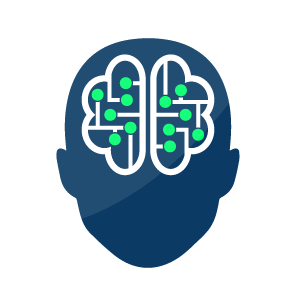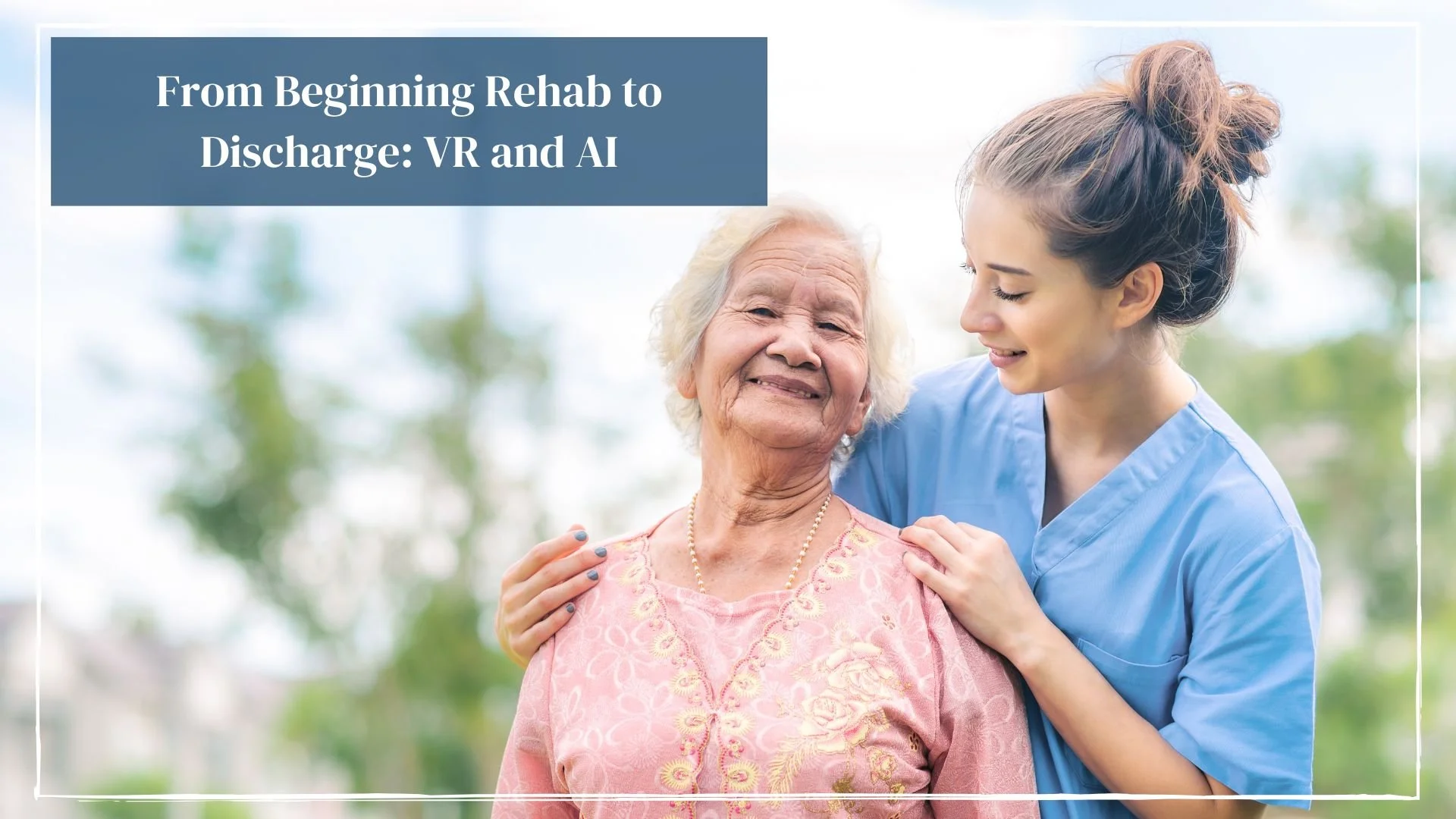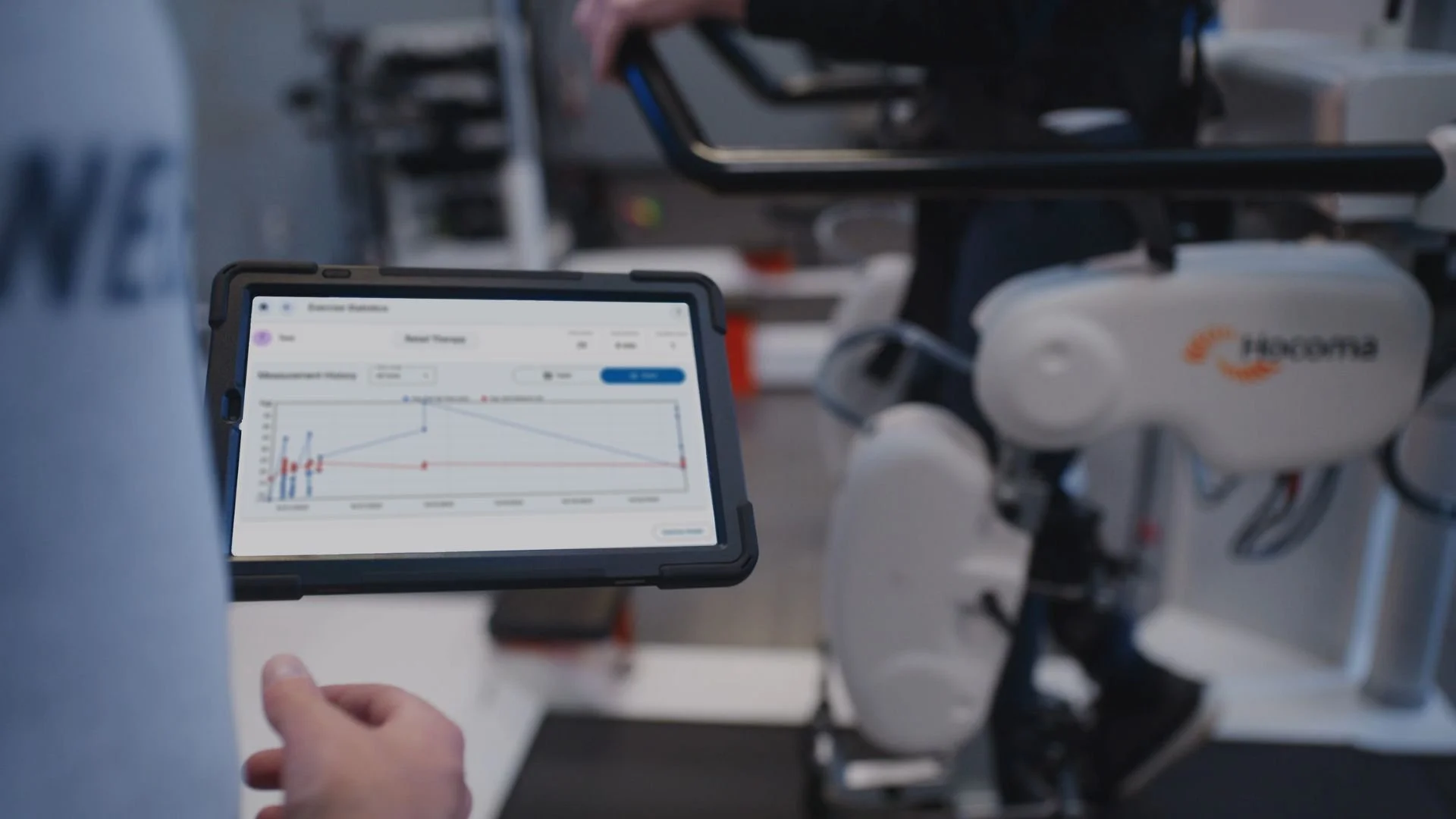From beginning rehab to Discharge: VR and AI
Written by: Brianna Hodge
Imagine walking into a therapy clinic, not feeling anxious, but curious. You're greeted by a headset, headphones, and a screen that feels more like a window into a different world than a piece of medical equipment. That’s how it starts for many today, especially in groundbreaking setups using Virtual Reality (VR) and Artificial Intelligence (AI) to transform traditional therapy workflows. It doesn’t sound like therapy, but here you are, from intake to discharge, immersed, motivated, and empowered.
In this blog, we'll take that journey together, intake, goal‑setting, progress tracking, and neurorehabilitation, seeing how VR and AI fit into each step. We’ll walk through real studies, real case examples, and explore how these technologies are reshaping the therapy experience.
Rowan-Cabarrus Community College
Intake & Evaluation: Welcome to a Smarter, More Comfortable Beginning
The very first step, intake or evaluation, can often feel clinical, even cold. Yet with VR, it can become immersive and interactive. For instance, one of the partners of Neuro Rehab VR said that they had integrated VR into its pain‑management clinic, emergency department, and behavioral‑health clinic. The result? High patient satisfaction, improved outcomes, and even operational buy-in, VR shifted from novelty to integral in long‑term use.
Now let’s bring AI into the picture. With Neuro Rehab VR’s integrated AI system, every assessment conducted in VR doesn’t just capture movement, cognitive task performance, or simulation data, it automatically translates those results into complete, standards-compliant SOAP notes. As you move through evaluations, the AI documents objective measures like repetitions, reaction time, and range of motion, while also pulling in therapist observations for the “Subjective” and “Assessment” sections. By the time the session ends, your SOAP note is ready, accurate, detailed, and HIPAA-compliant, without the clinician spending extra time typing. This approach transforms AI from a passive data collector into an active partner in the therapy process, removing one of the biggest workflow bottlenecks and letting therapists focus more on patient connection and care delivery.
Goal-Setting: Immersing You in Your Own Progress
Once the evaluation is complete, therapy often shifts to setting goals, but who really remembers cold, clinical wording? With VR, gamified environments can make goal‑setting feel dynamic and personal. When it comes to patient engagement, VR is shown to bring gamification, rewards, adaptive challenges, progress trackers, to keeps users involved and motivated.
Think of a stroke survivor using immersive VR games that simulate reaching for real‑world items, each grasp tracked, rewarded, and gently pushed toward small gains. That’s the kind of “goal-setting” where the goal is literally visible in the virtual environment.
Progress Tracking: Your Journey in Real Time
Traditional tracking often means pen‑and‑paper assessments or sporadic clinical observations. VR + AI can change that.
Research:
A recent systematic review and meta-analysis on computer-mediated therapies for stroke rehabilitation found compelling evidence that immersive virtual reality (IVR) may outperform non-immersive VR and, in many cases, match or even exceed the effectiveness of conventional therapy for improving upper-limb activity and daily living skills. One of the key advantages noted wasn’t just the immersive nature of the therapy itself, but the technology’s ability to provide built-in tracking of movement accuracy, repetition counts, and performance quality.
This level of automated, precise measurement allows clinicians to monitor progress in real time, adapt exercises to patient needs, and maintain objective records without additional manual tracking,making it a natural fit for streamlined, data-driven rehabilitation workflows. (Mugisha et al.)
Research:
The Feasibility of a Virtual-Reality-Enabled At-Home Telerehabilitation Program for Stroke Survivors case study demonstrated how VR can extend high-quality care beyond the clinic, even to rural settings. In this example, a stroke survivor living in rural Canada participated in a home-based VR program that allowed therapists to remotely monitor their progress.
Using standardized measures such as the Fugl-Meyer Assessment, walk tests, and cognitive exams, clinicians could track improvements in mobility, coordination, and mental function, all supported by objective, session-by-session data collected in VR. This approach not only ensured continuity of care but also eliminated the travel barriers that often limit rehabilitation access in remote areas, showing how VR telerehabilitation can keep patients engaged and clinicians fully informed without being in the same physical space.(Choukou et al.)
Now, layer in AI, and you have systems adjusting challenges, giving feedback, and even summarizing progress for clinicians and patients in clear dashboards.
Neuro-Rehabilitation VR: A Deep Dive
Let’s pause and go deeper on this, with real research and examples.
A narrative review exploring robotic and VR technologies for stroke survivors emphasized significant functional improvement when VR was added to rehabilitation plans. (Aderinto et al.)
A 2024 scoping review of immersive VR for upper‑extremity (UE) rehab in neurological disorders found most studies reported improvements,highlighting its promise for personalized and intensive training, especially in telerehab contexts. (Matteo Ceradini et al.)
The study on the Virtual Reality–Based Neurorehabilitation Support Tool showed that immersive, co-designed VR systems can be both practical and engaging in inpatient acquired brain injury care, offering advantages such as higher patient motivation, intuitive interaction, and the ability to deliver targeted cognitive exercises in a controlled, adaptable environment. (Prats-Bisbe et al.)
A 2025 study co‑creating immersive VR training environments found that combining clinician expertise and VR developers led to environments tailored to different cognitive demands. (Cucinella et al.)
These aren’t sci‑fi; they show how VR becomes more than a tool,it becomes therapy that adapts, measures, and motivates
From Engagement to Discharge: Ending the Journey with Confidence
Going through therapy can be long, discouraging, and yet studies show VR shifts that.
Consider seniors (aged 65‑103) using VR experiences, like parachuting, petting puppies, or revisiting global landmarks. Results were staggering: 80% felt more positive, 60% felt less isolated, 75% of caregivers saw mood improvements, and conversations sparked deeper connections. (SPENCER)
That emotional uplift matters. Discharge is not just functional improvement, it’s emotional readiness to step back into life. VR, often dismissed as “gimmicky,” becomes a closing chapter that matters.
Patient Engagement & Emotional Impact: Why the “Human” Still Matters
When we think about therapy workflow, it’s easy to focus only on the clinical markers, ROM (range of motion), gait speed, grip strength. But patients don’t experience their recovery as a spreadsheet. They live it in moments: feeling less pain in the morning, walking to the mailbox for the first time, cooking dinner without fatigue. That’s where VR has an edge, it gives those moments back sooner.
Research:
The systematic review on virtual reality and cognitive rehabilitation for older adults with mild cognitive impairment found that VR-based cognitive therapy often led to stronger and more sustained improvements in working memory and attention compared to traditional interventions. Researchers attributed these benefits not solely to the “practice effect” of repeated cognitive exercises, but also to the heightened emotional engagement and enjoyment that immersive environments provide. By making therapy feel more interactive and less clinical, VR increased participants’ willingness to attend sessions consistently, reinforcing cognitive gains over time and supporting better long-term outcomes. (Tortora et al.)
In practical terms, VR helps bridge the gap between what you can do and what you feel ready to do. A patient recovering from a stroke may logically know they can walk without a cane, but emotionally, they’re still afraid. In VR, they can safely “walk” a busy street, cross a crosswalk, or navigate a grocery aisle,all without real-world consequences. That repeated exposure retrains not just muscles, but confidence.
AI Integration Throughout: The Quiet Partner in the Background
While VR takes the spotlight with its immersive visuals and engaging experiences, AI is the steady, behind-the-scenes partner making everything smoother.
In rehabilitation settings, AI is increasingly used for:
Adaptive Difficulty: AI algorithms analyze patient performance in real time and automatically adjust task complexity. If you’re breezing through balance exercises, it might add dual-task elements (e.g., counting backwards while stepping) without a therapist needing to pause and recalibrate.
Predictive Analytics: By collecting thousands of data points from each session, AI can forecast potential plateaus or regressions before they’re visible to the human eye.
Automated Documentation: Systems like Neuro Rehab VR’s AI-powered SOAP note generator, free therapists from hours of manual charting. The AI not only logs repetitions, durations, and scores but also contextualizes them into clear, standards-compliant progress notes.
The beauty here? The technology doesn’t replace the therapist,it amplifies their ability to focus on connection, coaching, and problem-solving.
Neuro Rehab VR: Bringing It All Together in a Smart Therapy Complete Solution
At Neuro Rehab VR, the integration of VR and AI isn’t an afterthought,it’s the foundation of the Smart Therapy Complete Solution. This FDA-registered Class II medical device is built for the full patient journey:
Evaluation: Therapists can run initial assessments in VR, capturing detailed movement and cognitive data instantly.
Goal Setting: Built-in game modules align directly with patient goals (e.g., improving reach range, dynamic balance, or reaction time).
Progress Tracking: The system automatically records every metric,reps, success rates, movement smoothness,and visualizes progress for both clinician and patient.
AI Automation: Veda auto-generates therapy notes from each session, pulling directly from the data collected in VR.
Remote Readiness: Compatible headsets allow therapy continuation at home, with clinician oversight.
By combining immersive therapy with AI-driven documentation and analytics, Neuro Rehab VR reduces workflow bottlenecks, improves patient adherence, and helps clinicians spend more time with patients, not in front of screens.
Challenges and Considerations
No technology is a magic wand. To implement VR and AI effectively, clinics must address:
Therapist Training: Therapists new to VR often express initial concerns about complexity and patient safety, but these tend to decrease significantly once they receive hands-on training and become familiar with the technology.
Patient Comfort: Cybersickness is rare with modern headsets but still possible,especially for those with vestibular issues. Gradual exposure and adjustable environments can mitigate this.
Accessibility: While VR can bridge distance for rural patients, not every home has the space, internet speed, or caregiver support needed for at-home sessions. Hybrid models (clinic + home) may be the most practical starting point.
Equity: Clinics must ensure technology is available across demographics, avoiding the creation of a “digital divide” in rehabilitation care.
Discharge: The End That Feels Like a Beginning
Discharge day marks a significant milestone in the rehabilitation journey, but it’s far from the end. In many ways, it’s a transition point where the structure and support of formal therapy give way to the need for ongoing self-management. Without proper follow-through, even the most impressive gains can gradually diminish. This is where VR plays a powerful role in sustaining momentum.
Because VR therapy is immersive and engaging, patients are more likely to maintain their rehabilitation routines long after leaving the clinic. Whether it’s continuing exercises at home, joining VR-based group sessions in community centers, or accessing guided telerehab programs, the technology keeps the experience fresh and motivating. Progress tracking tools and built-in feedback loops give patients tangible proof of improvement, reinforcing the habit of regular participation.
With VR-enabled telerehabilitation, the therapist-patient connection doesn’t have to end at discharge. Therapists can monitor performance remotely, adjust programs in real time, and provide encouragement or corrections as needed. This continuous cycle of engagement, feedback, and adaptation helps ensure that the functional improvements achieved in therapy become lasting, real-world capabilities, turning discharge from a closing chapter into the start of long-term independence and confidence.
Looking Ahead: The Future of Workflow in VR and AI
We’re at the front edge of what’s possible. Imagine:
AI systems that cross-reference VR rehab data with wearable health trackers to flag early warning signs of falls or cardiovascular strain.
Fully personalized VR worlds created on-the-fly based on a patient’s real-time performance and mood.
Integration with EHRs so that intake, therapy, progress, and discharge are seamlessly documented without a single duplicate entry.
These advances won’t just streamline workflow,they’ll redefine it. The therapy journey will be less about rigid protocols and more about dynamic, responsive care.
Conclusion: A More Human Therapy Through Technology
The irony is that the more technology we integrate into therapy,the more human it can feel. When VR handles the engagement and AI handles the admin load, therapists are free to be what patients need most: present, attentive, and adaptive.
From the first evaluation to the moment you walk out the door, these tools can turn rehabilitation into an experience that’s not only more efficient, but also more motivating, personal, and sustainable.
If you’re a clinician, think about how VR and AI could help you spend less time on repetitive tasks and more time connecting with patients.
If you’re a patient or caregiver, know that technology is evolving to meet you where you are, and to help you get where you want to go.
-
Aderinto, Nicholas, et al. “Exploring the Efficacy of Virtual Reality-Based Rehabilitation in Stroke: A Narrative Review of Current Evidence.” Annals of Medicine, vol. 55, no. 2, 27 Nov. 2023, https://doi.org/10.1080/07853890.2023.2285907.
Choukou, Mohamed-Amine, et al. “Feasibility of a Virtual-Reality-Enabled At-Home Telerehabilitation Program for Stroke Survivors: A Case Study.” Journal of Personalized Medicine, vol. 13, no. 8, 1 Aug. 2023, p. 1230, www.mdpi.com/2075-4426/13/8/1230, https://doi.org/10.3390/jpm13081230.
Cucinella, Salvatore Luca, et al. “Towards Personalized Immersive Virtual Reality Neurorehabilitation: A Human-Centered Design.” Journal of NeuroEngineering and Rehabilitation, vol. 22, no. 1, 20 Jan. 2025, https://doi.org/10.1186/s12984-024-01489-5.
Matteo Ceradini, et al. “Immersive vr for Upper-Extremity Rehabilitation in Patients with Neurological Disorders: A Scoping Review.” Journal of Neuroengineering and Rehabilitation, vol. 21, no. 1, 11 May 2024, https://doi.org/10.1186/s12984-024-01367-0.
Mugisha, Stanley, et al. “Computer-Mediated Therapies for Stroke Rehabilitation: A Systematic Review and Meta-Analysis.” Journal of Stroke and Cerebrovascular Diseases, vol. 31, no. 6, June 2022, p. 106454, https://doi.org/10.1016/j.jstrokecerebrovasdis.2022.106454.
Prats-Bisbe, Alba, et al. “Virtual Reality–Based Neurorehabilitation Support Tool for People with Cognitive Impairments Resulting from an Acquired Brain Injury: Usability and Feasibility Study.” JMIR Neurotechnology, vol. 3, 18 Mar. 2024, pp. e50538–e50538, https://doi.org/10.2196/50538.
SPENCER, TERRY . ““Soaring” over Hills or “Playing” with Puppies, Study Finds Seniors Enjoy Virtual Reality.” AP News, 19 Feb. 2024, apnews.com/article/virtual-reality-seniors-florida-dementia-c2989fcfb5dca58639fbc0f8060d1eff.
Tortora, Carla, et al. “Virtual Reality and Cognitive Rehabilitation for Older Adults with Mild Cognitive Impairment: A Systematic Review.” Ageing Research Reviews, vol. 93, 1 Jan. 2024, p. 102146, www.sciencedirect.com/science/article/pii/S1568163723003057, https://doi.org/10.1016/j.arr.2023.102146.





